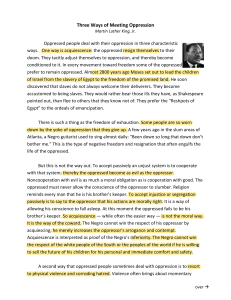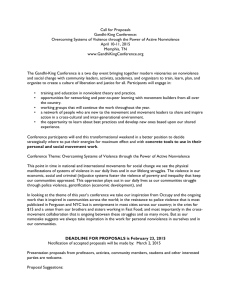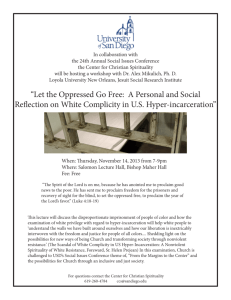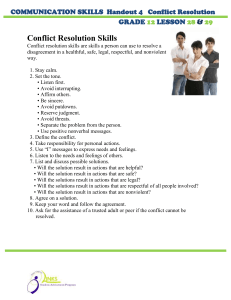Read the following passage from Martin Luther King, Jr. Then,... passage which ask you to draw conclusions about the approaches...
advertisement
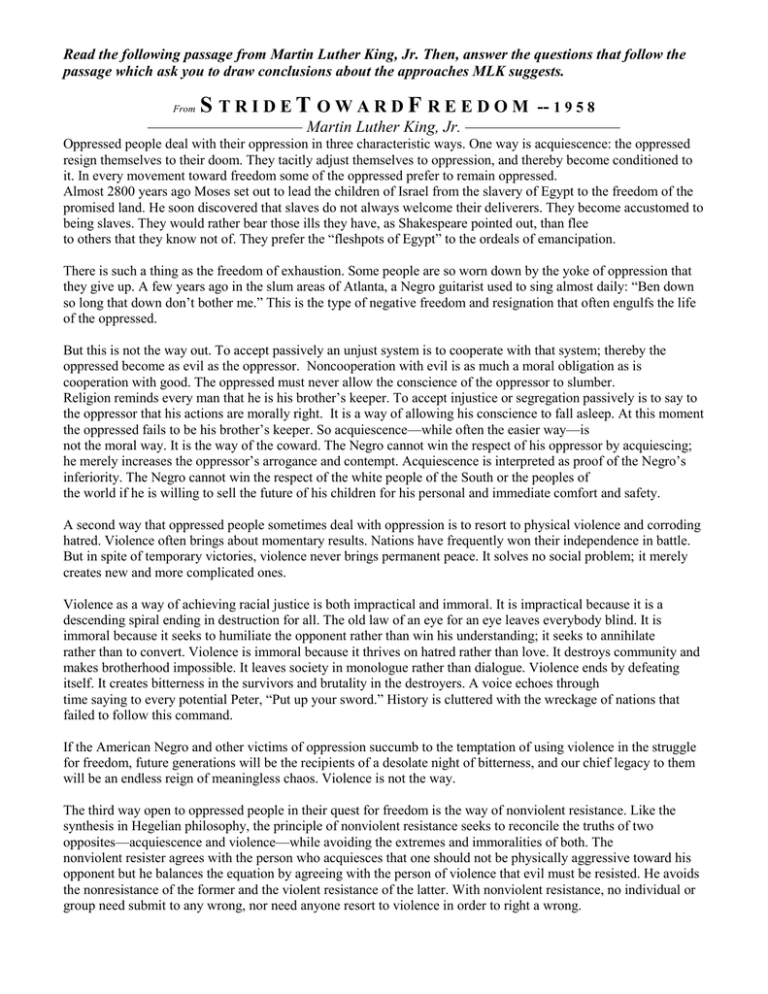
Read the following passage from Martin Luther King, Jr. Then, answer the questions that follow the passage which ask you to draw conclusions about the approaches MLK suggests. From S TRIDET OWARDF REEDOM -- 1 9 5 8 ––––––––––––––––––– Martin Luther King, Jr. ––––––––––––––––––– Oppressed people deal with their oppression in three characteristic ways. One way is acquiescence: the oppressed resign themselves to their doom. They tacitly adjust themselves to oppression, and thereby become conditioned to it. In every movement toward freedom some of the oppressed prefer to remain oppressed. Almost 2800 years ago Moses set out to lead the children of Israel from the slavery of Egypt to the freedom of the promised land. He soon discovered that slaves do not always welcome their deliverers. They become accustomed to being slaves. They would rather bear those ills they have, as Shakespeare pointed out, than flee to others that they know not of. They prefer the “fleshpots of Egypt” to the ordeals of emancipation. There is such a thing as the freedom of exhaustion. Some people are so worn down by the yoke of oppression that they give up. A few years ago in the slum areas of Atlanta, a Negro guitarist used to sing almost daily: “Ben down so long that down don’t bother me.” This is the type of negative freedom and resignation that often engulfs the life of the oppressed. But this is not the way out. To accept passively an unjust system is to cooperate with that system; thereby the oppressed become as evil as the oppressor. Noncooperation with evil is as much a moral obligation as is cooperation with good. The oppressed must never allow the conscience of the oppressor to slumber. Religion reminds every man that he is his brother’s keeper. To accept injustice or segregation passively is to say to the oppressor that his actions are morally right. It is a way of allowing his conscience to fall asleep. At this moment the oppressed fails to be his brother’s keeper. So acquiescence—while often the easier way—is not the moral way. It is the way of the coward. The Negro cannot win the respect of his oppressor by acquiescing; he merely increases the oppressor’s arrogance and contempt. Acquiescence is interpreted as proof of the Negro’s inferiority. The Negro cannot win the respect of the white people of the South or the peoples of the world if he is willing to sell the future of his children for his personal and immediate comfort and safety. A second way that oppressed people sometimes deal with oppression is to resort to physical violence and corroding hatred. Violence often brings about momentary results. Nations have frequently won their independence in battle. But in spite of temporary victories, violence never brings permanent peace. It solves no social problem; it merely creates new and more complicated ones. Violence as a way of achieving racial justice is both impractical and immoral. It is impractical because it is a descending spiral ending in destruction for all. The old law of an eye for an eye leaves everybody blind. It is immoral because it seeks to humiliate the opponent rather than win his understanding; it seeks to annihilate rather than to convert. Violence is immoral because it thrives on hatred rather than love. It destroys community and makes brotherhood impossible. It leaves society in monologue rather than dialogue. Violence ends by defeating itself. It creates bitterness in the survivors and brutality in the destroyers. A voice echoes through time saying to every potential Peter, “Put up your sword.” History is cluttered with the wreckage of nations that failed to follow this command. If the American Negro and other victims of oppression succumb to the temptation of using violence in the struggle for freedom, future generations will be the recipients of a desolate night of bitterness, and our chief legacy to them will be an endless reign of meaningless chaos. Violence is not the way. The third way open to oppressed people in their quest for freedom is the way of nonviolent resistance. Like the synthesis in Hegelian philosophy, the principle of nonviolent resistance seeks to reconcile the truths of two opposites—acquiescence and violence—while avoiding the extremes and immoralities of both. The nonviolent resister agrees with the person who acquiesces that one should not be physically aggressive toward his opponent but he balances the equation by agreeing with the person of violence that evil must be resisted. He avoids the nonresistance of the former and the violent resistance of the latter. With nonviolent resistance, no individual or group need submit to any wrong, nor need anyone resort to violence in order to right a wrong. It seems to me that this is the method that must guide the actions of the Negro in the present crisis in race relations. Through nonviolent resistance the Negro will be able to rise to the noble height of opposing the unjust system while loving the perpetrators of the system. The Negro must work passionately and unrelentingly for full stature as a citizen, but he must not use inferior methods to gain it. He must never come to terms with falsehood, malice, hate, or destruction. Nonviolent resistance makes it possible for the Negro to remain in the South and struggle for his rights. The Negro’s problem will not be solved by running away. He cannot listen to the glib suggestion of those who would urge him to migrate en masse to other sections of the country. By grasping his great opportunity in the South he can make a lasting contribution to the moral strength of the nation and set a sublime example of courage for generations yet unborn. By nonviolent resistance, the Negro can also enlist all men of good will in his struggle for equality. The problem is not a purely racial one, with Negroes set against whites. In the end, it is not a struggle between people at all, but a tension between justice and injustice. Nonviolent resistance is not aimed against oppressors but against oppression. Under its banner consciences, not racial groups, are enlisted. If the Negro is to achieve the goal of integration, he must organize himself into a militant and nonviolent mass movement. All three elements are indispensable. The movement for equality and justice can only be a success if it has both a mass and militant character; the barriers to be overcome require both. Nonviolence is an imperative in order to bring about ultimate community. A mass movement of a militant quality that is not at the same time committed to nonviolence tends to generate conflict, which in turn breeds anarchy. The support of the participants and the sympathy of the uncommitted are both inhibited by the threat that bloodshed will engulf the community. This reaction in turn encourages the opposition to threaten and resort to force. When, however, the mass movement repudiates violence while moving resolutely toward its goal, its opponents are revealed as the instigators and practitioners of violence if it occurs. Then public support is magnetically attracted to the advocates of nonviolence, while those who employ violence are literally disarmed by overwhelming sentiment against their stand. 1. The word acquiescence most closely means A. to oppose B. to fight back C. to comply D. to appreciate 2. According to Martin Luther King, Jr., if people passively accept segregation, what does it imply? 3. According to MLK, why is the nonviolent approach superior to the violent approach? 4. What do you think about MLK’s views on nonviolent approach? Do you agree or disagree with his approaches or tactics? Why or why not?
